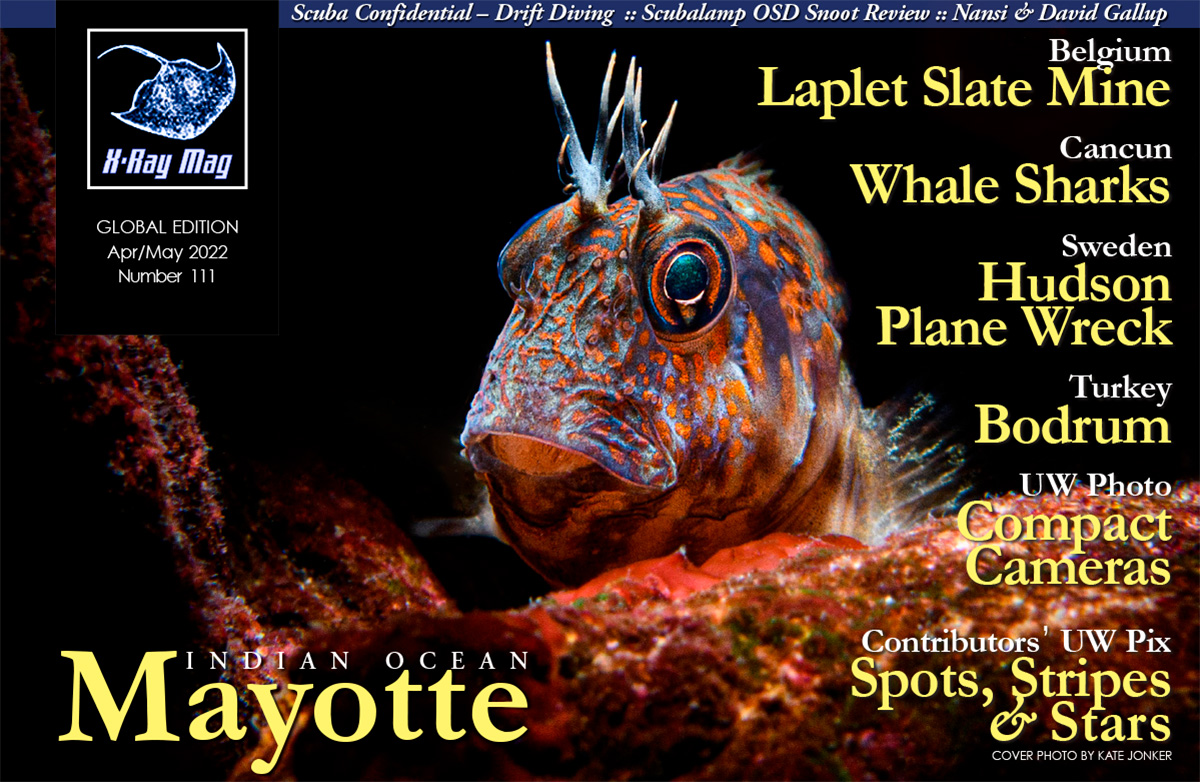For a cave diver, it is always an exciting moment to be the first to dive a location that has not been visited by other divers before. The Laplet slate mine in the Belgian Ardennes was such a location for our small group of explorers.


For a cave diver, it is always an exciting moment to be the first to dive a location that has not been visited by other divers before. The Laplet slate mine in the Belgian Ardennes was such a location for our small group of explorers.
One of the premier tourist destinations on Turkey’s Aegean coast, Bodrum is renowned for its beautiful coastal scenery, history and laid-back ambiance. Scott Bennett shares his diving, cultural and culinary adventure to this ancient city.
How to go with the flow underwater: Simon Pridmore provides tips and insights on the challenges and benefits of diving in current conditions.
The innovative new Scubalamp OSD Snoot was officially released in late 2021. Underwater photographer Kate Jonker took it through its paces and shares her review of the product as well as her stunning photos taken with it.
There are not many wrecks in the fjord of Gullmarn. What wrecks there are here should, of course, be slightly inaccessible, at a depth of 64m. For a long time, our dive team had talked about going down to the Hudson plane hidden in the fjord. Now, the wait was finally over
The oldest of the four large Comoros Islands, Mayotte is 295km west of Madagascar and 67km southeast of Anjouan. An overseas territory of France, it is surrounded by an elliptical barrier reef, 160km long, encircling a lagoon 5km to 10km wide, with a maximum depth of 80m, a dozen passes and dotted with a hundred coral islets. Pierre Constant takes us along on his adventure to this unique and multicultural oasis with an intriguing diversity of species both above and below the waves.
We asked our contributors what their favorite underwater photographs featuring spots, stripes and star patterns were, and they returned with a surprising range of subjects from delicate macro marine life to majestic manta rays. X-Ray Mag contributors share their favorite images from the tropical waters of Indonesia, Philippines, Malaysia, Papua New Guinea, Yap, Maldives, Mozambique, Hawaii and Red Sea to the subtropical and temperate waters of Turkey, New Zealand, South Africa, the US East Coast and British Columbia.
Even though compact cameras have been used in underwater photography for decades, familiarity with the compact camera today is still limited to a mere handful who have really exhausted its buttons, modes, scenes and capabilities.
American collaborative artists David Gallup and Nansi Bielanski Gallup create dynamic, compelling and atmospheric paintings of marine life and underwater scenes, rich with color, texture and light, inspired by their adventures under the waves. Well-traveled divers, the husband-and-wife team have dedicated their artistic endeavors to raising awareness and understanding of coral reef and ocean ecosystems. X-Ray Mag interviewed the artists to learn more about their artwork, creative process and conservation perspectives.
Some ocean animals are just inspiring. To be able to glimpse a massive animal like a whale shark can be a lifelong dream that some divers never get to experience. The ocean’s largest living fish inhabits all of the world’s tropical waters, but sightings are usually rare. However, there are a few seasonal hot spots where the likelihood increases. One of those hot spots is off the coast of Cancun and near Isla Mujeres and Isla Holbox, Mexico.
Be careful as regards how much camera equipment you bring into Mexico as your secondary or backup equipment could be considered an import which is liable to considerable taxes.
Following the closure of Russian airspace, many flights linking Europe and Southeast Asia have been forced to reroute, resulting in longer flight times and higher costs.
A new study suggests that great white sharks are more social than initially thought.
A bacterium can use the clear plastic that is used to make clothing fibres and drink bottles as its main source of nutrients, degrading the plastic in the process.
Images of Pluto captured by NASA's New Horizons mission have revealed ice volcanoes.
Airbus has performed a first A380 flight powered by 100% Sustainable Aviation Fuel (SAF).
Thanks to a symbiosis between seagrass and a nitrogen-fixing marine bacterium, seagrasses remove large amounts of carbon dioxide from the atmosphere and store it in the ecosystem.
NOAA announces the discovery of the wreck of a 207-year-old whaling ship, called Industry, found on the bottom of the Gulf of Mexico.
Maritime archaeologists from the Museum of Wrecks have recently explored and identified six shipwrecks on the sea floor in the Blekinge archipelago of Sweden. To protect the strategic naval city of Karlskrona and prevent attacks by sea, the ships had been sunk in the Djupasund strait.
The Endurance22 Expedition has located the wreck of Endurance, Sir Ernest Shackleton's ship which has not been seen since it was crushed by the ice and sank in the Weddell Sea in 1915.
Could the cure for melanoma—the most dangerous type of skin cancer—be a compound derived from a bottom-dwelling sea squirt?
The wide array of colours and patterns in a group of tropical reef fishes is likely due to a genomic architecture that enables rapid diversification.
Caladan Oceanic conducted the first-ever crewed dive to the deepest point of the Atacama Trench (Peru-Chile), the deepest trench in the southeastern Pacific. The maximum depth recorded at the Atacama Trench's lowest point was 8,069m.
A particular species of moray eel has been found to hunt not only underwater, but on land as well.
It seems that the question of how much baleen whales eat every day is one that has far-reaching implications not just for the whales themselves, but entire oceanic ecosystems as well.